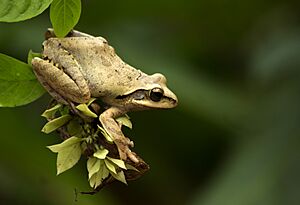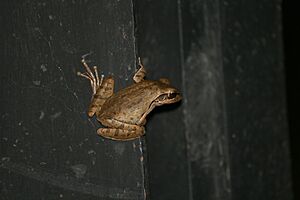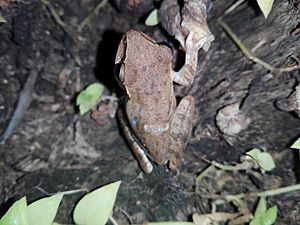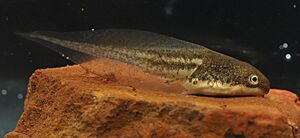Indian tree frog facts for kids
Quick facts for kids Indian tree frog |
|
|---|---|
 |
|
| Conservation status | |
| Scientific classification | |
| Genus: |
Polypedates
|
| Species: |
maculatus
|
| Synonyms | |
|
|
The Polypedates maculatus, also known as the Indian tree frog or Chunam tree frog, is a common type of frog. You can find these frogs living in South Asia. A scientist named John Edward Gray first described this species in 1830.
For a while, the Himalayan tree frog was thought to be a type of Indian tree frog. However, scientists now consider it a separate species. Another similar frog, Polypedates leucomystax, was also once grouped with the Indian tree frog.
Contents
What Does the Indian Tree Frog Look Like?



Indian tree frogs are about 7 to 8 centimeters (about 3 inches) long. They are usually brownish, yellowish, greyish, or whitish on their backs. They often have darker spots or patterns. Sometimes, they even have a shape like an hourglass on their head and upper back.
The areas around their eyes and temples are dark. They also have a light line along their upper lip. The back of their thighs has round, yellow spots. These spots are usually separated by a dark-brown or purplish pattern.
Their skin feels smooth on their back. But on their belly and under their thighs, it feels bumpy. There's also a skin fold that goes from their eye to their shoulder. Male frogs have special sacs inside their throats that help them make calls.
Hands and Feet
The fingers of these frogs are only slightly webbed. Their toes are about two-thirds webbed, which means they have skin between them. This webbing helps them climb and swim.
The tips of their fingers and toes have special pads. These pads help them grip surfaces. When their back leg is stretched out, their ankle can reach their eye or even the tip of their snout.
Where Do Indian Tree Frogs Live?
You can find the Indian tree frog in many places across South Asia. This includes countries like Bhutan, India, Nepal, and Sri Lanka. They also live in western and southern Bangladesh. It's possible they might also be found in nearby parts of China and Myanmar.
This frog is very common and can adapt to different places. Because of this, the IUCN (a group that tracks animal populations) lists it as "Least Concern." This means their population is healthy and not in danger.
Daily Life and Habits
Indian tree frogs often use the same spots to rest during the day. Their call sounds like a quick, rattling "rat-tat-tat."
These frogs have a cool way to stay moist. They rub their skin with special liquids. These liquids are made of mucus and fats, which help them keep water in their bodies. When it gets hotter, they can "sweat" from their skin and pant. They also change their skin to lighter colors to help them cool down.
In some parts of south India, these frogs can even come into people's homes. They climb walls using their webbed feet and can reach high floors. They often enter through open windows, looking for food.
Images for kids




